Exploring the Aesthetics of Studio Apartments
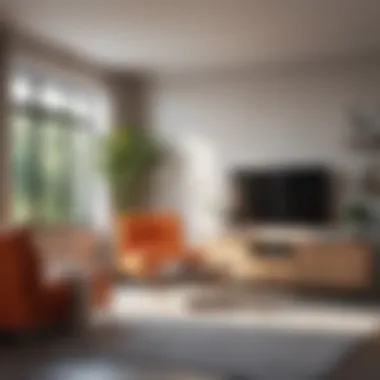
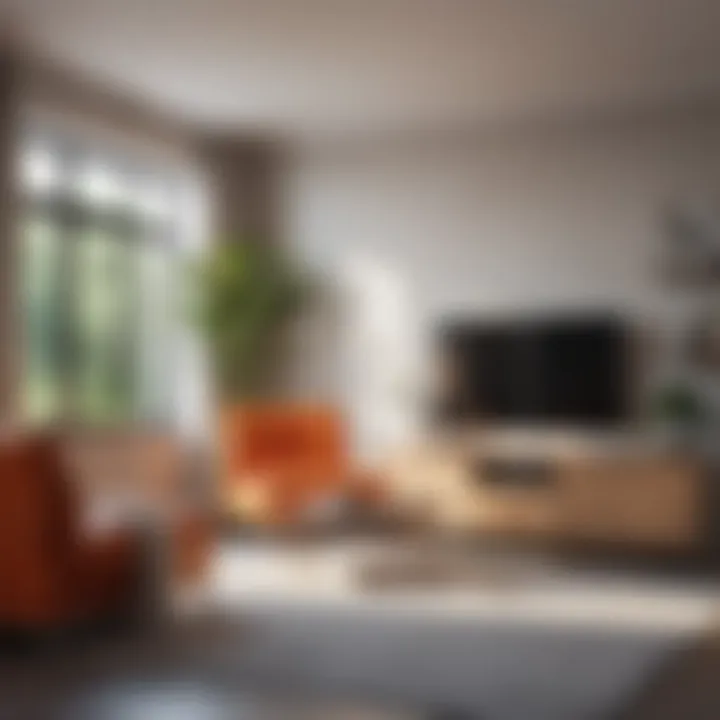
Intro
Studio apartments have gained immense popularity, especially in urban environments. These compact living spaces ingeniously blend function and form, catering to the needs of city dwellers. The layout typically consists of a single room that combines living, sleeping, and kitchen areas. This article explores the unique characteristics of studio apartments, looking at their aesthetics and functionality.
In this exploration, we will examine various elements that define studio living, including space-saving furniture designs, current interior decor trends, and their adaptability to different lifestyles. Furthermore, we will discuss the impact of location on what makes studio apartments appealing to potential residents. Let's uncover the charm and practicality of these distinctive living spaces.
Inspiring Homes
Thoughtful Layouts
An essential aspect of studio apartments is their creative layouts. Designers often utilize open floor plans to enhance the perception of space. This approach allows for flexibility in furniture arrangement, making the environment feel more spacious. Hooking to certain aesthetic ideals, many studio apartments incorporate large windows, flooding the area with natural light and further expanding the visual space.
Space-Saving Solutions
Choosing the right furniture is critical in a studio apartment. Here are some popular options:
- Murphy beds: These can fold up into the wall, freeing up floor space during the day.
- Convertible sofas: Dual-functionality allows for comfortable seating and sleeping arrangements.
- Nesting tables: These save space by stacking together when not in use yet provide ample surface area when required.
Incorporating multipurpose items helps maintain the flow of the apartment, making it an efficient yet stylish abode.
Design Trends
Current interior design trends strive to blend minimalism with warmth. Many studio apartments favor neutral color palettes to create a soothing environment. Using textured materials, such as wood and metal, can offer visual contrast against the simplicity of the design. Additionally, adding plants or unique art pieces introduces personality without overwhelming the space.
"Quality over quantity is key in studio design. Thoughtful accents can turn a small area into an inviting home."
Practical Functionality
Functionality in studio apartments means balancing comfort and efficiency. Here are key considerations:
- Zoning: Utilizing rugs or furniture to define different areas can make the space appear organized.
- Storage: Good storage solutions like wall shelves or under-bed bins help in clutter management.
- Location: The apartment's location affects lifestyle choices, with easier access to public transport often being a deciding factor.
By paying close attention to both aesthetics and practical needs, studio apartments can become highly desirable living spaces. An informed choice behind each design aspect will contribute to the overall functionality of the environment.
Culmination
Foreword to Studio Apartments
Studio apartments represent a unique blend of aesthetics and functionality, making them a viable option for many urbanites. Understanding studio apartments requires recognizing their multifaceted nature. These small units often integrate various living spaces into a singular environment which can be both challenging and invigorating. For individuals and couples seeking compact living solutions, studio apartments provide numerous advantages.
The importance of this introductory section lies in establishing a foundational knowledge of what studio apartments are and why they hold relevance in today’s real estate landscape. Increasing urbanization has led to a surge in popularity of these spaces. Dense populations in cities require housing solutions that maximize efficient use of space.
In examining studio apartments, one must consider key elements such as affordability, accessibility, and adaptability. These units often appeal to young professionals and students who prioritize location over square footage.
Key Benefits of Studio Apartments
- Affordability: Often, studio apartments are more budget-friendly compared to larger units. This cost efficiency allows residents to allocate their finances to other aspects of life.
- Minimalist Lifestyle: With less space comes the necessity for decluttering. Studio living encourages simplicity and thoughtful curation of belongings.
- Proximity to Amenities: Many studio apartments are located in desirable urban areas, placing residents close to workplaces, schools, and entertainment options.
- Customization Potential: The open designs of studios lend themselves to creative modifications, allowing residents to personalize their living spaces according to their preferred aesthetics.
With these advantages, the essence of studio living is not merely about coping with limited space. Instead, it is about cultivating an environment that reflects individual lifestyle choices while maintaining practicality. This section sets the stage to explore the specific characteristics and features that define these compact units, guiding readers through the next parts of the article.
Defining Studio Apartments
Defining studio apartments is essential for understanding their appeal and versatility. These compact living spaces integrate various functions into one area, serving as a bedroom, living room, and kitchen all at once. This layout can be particularly attractive to urban residents, who often face limited space and high rental costs. By examining the specific characteristics and advantages of studio apartments, one gains insights into how they fulfill modern living needs.
Layout and Design
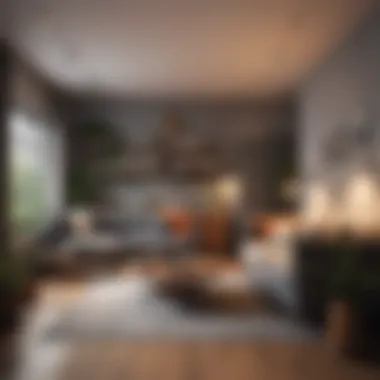
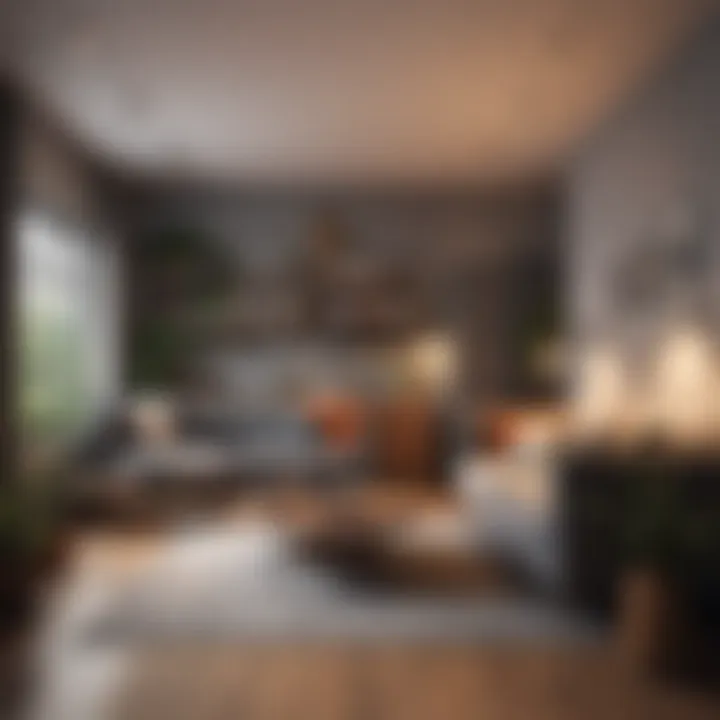
The layout of studio apartments is a crucial factor in their functionality. Unlike traditional apartments that separate rooms, studios utilize an open floor plan. This design not only makes the space feel larger, but it also encourages creativity in decor and furniture placement. Homeowners and renters can arrange their belongings in ways that reflect personal style while maintaining practical usability.
Key components of the layout include:
- Kitchenette: Typically, studios feature a compact kitchen or kitchenette, which may include essential appliances like a stove, mini-fridge, and microwave. This setup allows residents to prepare basic meals without requiring extensive kitchen space.
- Living Area: The area must serve multiple purposes. Residents might use pull-out sofas or Murphy beds to optimize available space, switching from a living area to a sleeping space at will.
- Bathroom: Most studios have a separate bathroom, providing necessary privacy. In some cases, the design may allow for an additional closet space, which enhances overall organization.
The overall design should focus on functionality. Attention to detail in layout promotes efficient use of space, essential for comfort and livability.
Size Variations
Size variations in studio apartments make them adaptable to different needs and budgets. Studios can range from around 300 square feet to over 600 square feet, impacting their appeal based on lifestyle and preferences.
Considerations regarding size include:
- Compact Studios: Smaller studios, typically around 300 to 400 square feet, tend to attract individuals who prioritize affordability and minimalism. They are often ideal for students or young professionals who spend much of their time outside the home.
- Medium to Large Studios: These studios may provide more space for additional furniture or even a small dining area. They are suited for couples or individuals needing a bit more room to maneuver, especially if hosting friends or family.
- Layouts with Nooks or Alcoves: Some larger studios incorporate nooks or alcoves for sleeping or workspaces. This feature provides a semblance of separation between areas, improving privacy without compromising the open layout.
Key Features of Studio Apartments
The significance of the key features of studio apartments lies in their ability to create compact yet multifunctional living spaces that cater to modern urban lifestyles. The distinct advantages of these key elements are immediate and tangible, showcasing how thoughtful design can maximize utility while maintaining aesthetic appeal. Understanding these features not only helps potential buyers or renters make an informed decision, but it can also inspire interior design choices that enhance the livability of these spaces.
Open Floor Plans
Open floor plans are arguably the hallmark of studio apartments. Unlike traditional apartment layouts that often separate living and sleeping areas, a studio embraces a well-integrated space where all functions blend seamlessly. This design choice makes a studio feel more spacious than its actual size. The lack of walls creates a natural flow between areas, promoting a relaxed atmosphere. This layout allows residents to easily arrange their furniture and incorporate elements that suit their lifestyle.
Benefits of open floor plans include:
- Versatility: One can easily adapt the same space for different activities, such as working, entertaining, or relaxing.
- Enhanced Natural Light: Fewer walls mean more light can permeate the space, creating a bright and inviting environment.
- Simplicity: The minimalist design often encourages a clutter-free living space, essential for those who thrive in organized settings.
Multifunctional Furniture
In studio apartments, space is often at a premium. Hence, the use of multifunctional furniture is crucial. Items that serve dual purposes help maximize utility without compromising style. For instance, a sofa bed can transform a lounge area into a sleeping space. Additionally, an extendable dining table can accommodate guests while not taking up too much room when not in use.
Examples of useful multifunctional furniture include:
- Murphy Beds: These beds fold up against the wall, freeing floor space during the day.
- Ottomans with Storage: These pieces can serve as both seating and hidden storage for blankets or magazines.
- Convertible Desks: Workspaces that can be retracted or transformed depending on needs.
Storage Solutions
Effective storage solutions are essential in a studio apartment. A lack of traditional storage options can lead to clutter, which negates the benefits of living in such a compact space. Thoughtful integration of storage solutions not only keeps the space organized but can also enhance its aesthetic appeal.
Key storage strategies include:
- Vertical Space Usage: Utilizing wall shelves and tall cabinets can help draw the eye upward, creating an impression of height in the apartment.
- Under-bed Storage: This area can be ideal for boxes or drawers, making it easy to access items while keeping them out of sight.
- Built-In Units: Custom or fitted furniture installations help maximize every nook and cranny of the apartment.
Effective storage solutions are crucial in creating balance in a studio. They allow for functionality without sacrificing the visual integrity of the living space.
By considering these key features—open floor plans, multifunctional furniture, and innovative storage solutions—one can realize the potential of studio apartments. They are not merely small spaces but rather efficient, stylish homes for individuals or couples navigating the complexities of urban living.
Aesthetic Considerations
Aesthetic considerations play a crucial role in the overall appeal of studio apartments. In a space where functionality often competes with design, striking a harmonious balance becomes essential. This section delves into the core elements that contribute to the attractiveness of studio apartments, focusing on current design trends, effective use of color schemes, and innovative lighting options. Good aesthetic choices not only enhance the visual experience but also promote a more comfortable living environment.
Design Trends
Modern studio apartments reflect the evolution of interior design. Several trends are gaining popularity, which contribute to the uniqueness of these spaces. Many residents now prefer minimalism, characterized by clean lines and uncluttered spaces. This style makes rooms feel larger and more open. Additionally, biophilic design, which emphasizes connection to nature, is becoming increasingly accessible. Including plants or natural materials can breathe life into these compact areas.
Another trend is the use of mixed materials. For instance, pairing wood with metals presents a contemporary contrast that can make a space feel both warm and industrial. Open shelving is also favored, allowing decorative items to be showcased while promoting a sense of openness. These design trends are not just about aesthetics; they enable a personalized expression that caters to diverse tastes among inhabitants.
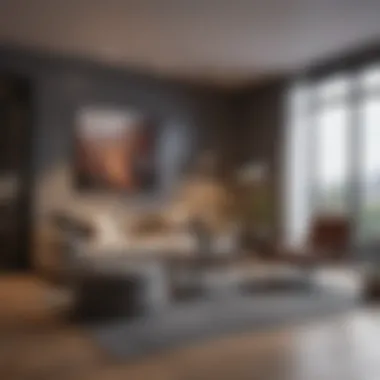
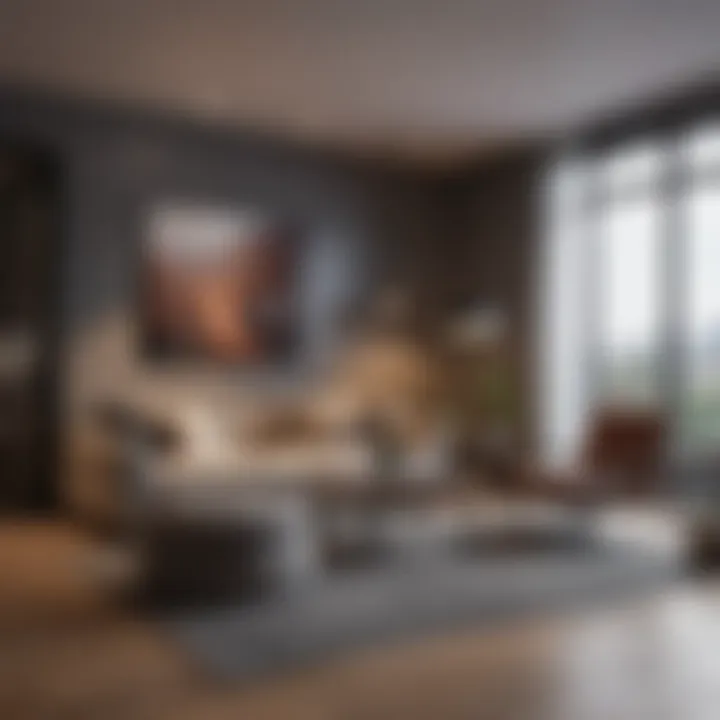
Color Schemes
Choosing the right color scheme is vital for maximizing the emotional response to a studio apartment. Light colors can significantly affect a room's perception. Shades like whites, soft blues, and pastels help create an illusion of spaciousness. On the other hand, darker colors can evoke coziness but may require careful planning to prevent spaces from feeling cramped.
When combining colors, accents in bold or contrasting colors can serve as focal points. For example, a vibrant piece of art or a brightly colored sofa can liven up a neutral backdrop. An effective color scheme should enhance the aesthetic appeal while aligning with the resident's style preferences. Additionally, understanding the psychology of colors can aid in making decisions that positively influence mood and ambiance.
Lighting Options
Lighting is one of the most important elements for creating an appealing lspace. In studio apartments, where space can be limited and natural light may not always be present, strategic lighting becomes essential. The use of layered lighting—ambient, task, and accent—ensures that all functional requirements are met while creating visual interest.
For ambient lighting, soft overhead fixtures or pendant lamps can provide a general illumination to the space. Task lighting is crucial in areas such as the kitchen or workspace, where focused lighting can enhance functionality. Accent lighting, such as LED strips behind shelves or sculptures, can highlight special design elements.
Furthermore, using mirrors can help amplify natural light and create a feeling of expansiveness. Thoughtful lighting not only enhances the beauty of the apartment but also influences daily tasks and comfort levels.
Understanding aesthetic considerations is key to maximizing the potential of studio apartments. With the right design trends, color choices, and lighting options, these compact living spaces can become a true reflection of one’s lifestyle and personality.
Functional Aspects of Living in a Studio
Studio apartments pose unique functional aspects that warrant careful consideration. Understanding these elements can significantly enhance the living experience for residents. The compact nature of studio apartments compels inhabitants to be mindful of every inch, often leading to innovative solutions for space and lifestyle requirements.
Efficient Use of Space
Efficient use of space is crucial in studio living. A successful studio design seamlessly integrates living, sleeping, and working areas without sacrificing comfort or style.
- Multi-functional furniture: Items such as sofa beds, foldable desks, and ottomans with storage allow individuals to maximize space while achieving functional versatility.
- Vertical storage solutions: Wall-mounted shelves and ceiling-high wardrobes effectively utilize vertical space, reducing clutter on the floor and maintaining an open atmosphere.
- Zoning techniques: Utilizing rugs, furniture arrangements, and decorative elements can visually separate distinct areas within a studio, creating a sense of division without physical barriers.
These strategies not only optimize space but also contribute to a more organized and enjoyable living environment.
Adapting to Different Lifestyles
The adaptability of studio apartments makes them appealing to various lifestyles. Whether someone is a busy professional, a student, or a creative individual, a studio can cater to diverse needs.
- Flexibility in design: Residents can personalize their environments to reflect their taste. This freedom fosters a sense of ownership and belonging, vital aspects for comfortable living.
- Living arrangements: Studios may also accommodate couples or roommates who prefer a compact and manageable living arrangement. The close quarters can promote stronger social connections.
- Lifestyle modifications: Those who embrace minimalism often find studio living ideal due to its emphasis on keeping only essential items, promoting a clearer mind and a more focused approach to daily living.
This versatility enhances the appeal of studio apartments across a broad demographic, making them relevant in urban housing markets.
Impact on Daily Living
Living in a studio apartment can significantly influence daily routines and behaviors. Understanding these impacts is essential for potential residents.
- Simplified routines: The compact size encourages a streamlined lifestyle. Reduced clutter can make managing daily tasks easier, from cooking to cleaning.
- Affordability: Studio apartments usually come at a lower price point compared to larger apartments, allowing residents to allocate their resources more effectively, whether toward savings, travel, or leisure activities.
- Community engagement: Often situated in vibrant neighborhoods, studio apartments foster connections to local culture and amenities. This engagement can enrich daily living and offer opportunities for socialization and personal growth.
The experiences shaped by these functional aspects inevitably influence one's lifestyle and well-being, cementing the role studio apartments play in modern urban living.
Comparing Studio Apartments with Other Apartment Types
Understanding studio apartments in context with other types of living spaces proves critical for potential residents or investors. Each apartment type serves distinct purposes catering to different lifestyles, preferences, and budget constraints. By comparing studio apartments with one-bedroom apartments, loft apartments, and efficiency apartments, one gains a complete perspective on the advantages and limitations inherent in each.
One-Bedroom Apartments
One-bedroom apartments offer a separate bedroom apart from the living space, providing a clear distinction between public and private areas. This feature appeals to individuals who require privacy, such as couples or those who frequently host guests.
Advantages of One-Bedroom Apartments:
- Defined Spaces: These apartments can mitigate noise, allowing for a quieter and more personal environment.
- Design Flexibility: This type of apartment allows more freedom in furnishing. Residents can create specific atmospheres in distinct areas.
- Intimacy and Comfort: A separate bedroom often translates to a coziness that is hard to replicate in a studio arrangement.
However, the trade-off often lies in the space efficiency. While one-bedroom units typically provide significant living area, they are generally larger and may come with higher utilities and rental costs than a studio apartment.
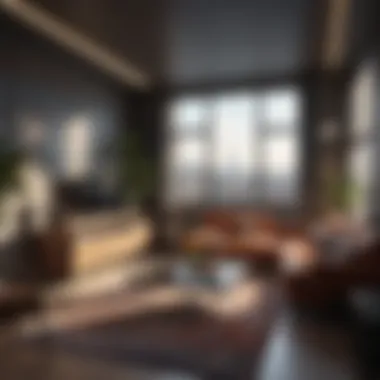

Loft Apartments
Loft apartments represent another unique form of urban living. Originally converted from industrial spaces, these apartments typically feature large open floor plans, high ceilings, and abundant natural light. While they may appear similar to studios at first glance, they often provide areas that can be somewhat separated, giving residents more layout options.
Key Features of Loft Apartments:
- Architectural Character: With their distinctive designs and historical charm, lofts may attract those seeking uniqueness.
- Spatial Freedom: High ceilings and open spaces may inspire creative design possibilities that elevate aesthetic appeal.
- Community Vibe: Many lofts are situated in vibrant neighborhoods, leading to a sense of belonging among residents.
Nevertheless, loft apartments can also present challenges. Heat and cooling could be less efficient because of the expansive space. Additionally, the open layout can lead to compromises on privacy, making them less suitable for individuals who prioritize separation.
Efficiency Apartments
Efficiency apartments, also known as studio apartments with a slightly different layout, provide a living arrangement that emphasizes concise space usage. These spaces usually consist of a single room for living and sleeping, with a small kitchenette and a separate bathroom.
Considerations for Efficiency Apartments:
- Cost-effective Living: Efficiency apartments often present lower rent options, beneficial for students or those entering the job market.
- Space Efficiency: They excel in maximizing every square foot, encouraging smart organizational strategies.
- Simplicity in Lifestyle: Minimalism often prevails in these spaces. This leads to reduced clutter and maintenance.
However, the sacrifice is typically in comfort and space versatility. Efficiency apartments might feel cramped for long-term living or accommodating guests.
"The choice among studio, one-bedroom, loft, and efficiency apartments largely depends on lifestyle preferences and budget considerations. Understanding each type’s characteristics helps in making informed decisions."
In summary, comparing studio apartments with other apartment types reveals important insights about urban living. Each style responds to the varied needs of its inhabitants, balancing aesthetics and functionality in unique ways. Ultimately, the choice of living arrangement is deeply personal and should align with one’s lifestyle, financial situation, and individual preferences.
The Role of Location
Location plays a crucial part in shaping the experience of living in a studio apartment. It greatly influences accessibility, lifestyle, and overall satisfaction. A well-located studio provides not only convenience but also a sense of community. Understanding this aspect helps potential residents make informed decisions about their living arrangements.
Choosing between urban and suburban environments is often driven by personal preferences and priorities. Each setting comes with unique benefits and challenges that can significantly affect daily life.
Urban vs. Suburban Settings
Urban settings offer high-density living, characterized by dynamic environments and convenience. Residents in cities experience a constant flow of cultural activities, dining options, and entertainment. The accessibility of public transportation enhances mobility, allowing for spontaneous outings. However, urban living often comes with noise, crowding, and possibly higher rent prices.
In contrast, suburban locations provide a quieter and more spacious atmosphere. The benefits here include lower cost of living and a greater sense of community. Suburban areas may feature green spaces and a slower pace of life. Nonetheless, they could lack the vibrancy and excitement of city life, and commuting may become a necessity.
Proximity to Amenities
The measure of a studio apartment also lies in its proximity to essential amenities. Access to grocery stores, hospitals, schools, and recreational spaces can make life much easier. A convenient location minimizes travel time, enhancing the overall livability of the apartment.
When listing the advantages of proximity to amenities, consider the following:
- Convenience: Quick access to daily necessities can reduce stress and improve quality of life.
- Social Engagement: Living near shops and restaurants encourages social interaction and a sense of belonging.
- Health and Fitness: Access to gyms and parks promotes an active lifestyle, contributing to overall wellness.
- Transportation Options: Proximity to public transport can make commuting practical and efficient.
In summary, the location of a studio apartment significantly affects its appeal and functionality. The choice between urban or suburban living can alter user experience. Additionally, being near essential amenities can enhance everyday life. Each aspect contributes to the decision-making process for individuals considering studio apartments.
The End
In closing, it is crucial to understand the multifaceted allure of studio apartments. These compact living spaces provide a unique blend of aesthetics and functionality that resonate with various lifestyle choices. The appeal lies not just in their design but also in their significant ability to adapt to the demands of urban living.
Key elements that enhance the understanding of studio apartments include:
- Their efficient layouts
- The use of multifunctional furniture
- Consideration of aesthetic trends
- The impact of location on desirability
By summarizing these aspects, one can appreciate how studio apartments allow residents to craft personalized environments within limited spaces. The design trends discussed earlier play a vital role in creating an inviting atmosphere, while functionalities improve daily living and productivity.
Moreover, the insights into location, which emphasize proximity to urban amenities, highlight the aspects that can significantly enhance the overall living experience. It becomes evident that a well-placed studio can contribute positively to both a person's lifestyle and daily routines.
Lastly, the inclusiveness of studio apartments caters to a wide audience, from young professionals seeking to establish independence to retirees wishing to downsize without compromising their quality of life. The nuanced examination of these spaces equips potential renters and buyers with valuable knowledge, guiding them in making informed decisions.
"Studio apartments signify more than just creative living arrangements; they embody a lifestyle choice that aligns with modern sensibilities."
Understanding studio apartments extends beyond visuals and compactness. It's about recognizing the principles behind their design and their favorable impact on contemporary life.



